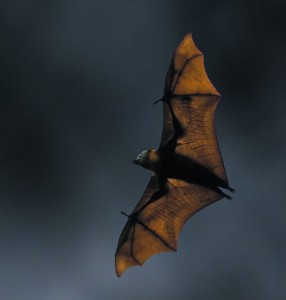MONDAY, 3 OCTOBER 2011
A new study has revealed that bat wings are covered in tiny sensory hairs, which detect air movement and significantly improve their ability to manoeuvre when flying.Bats are the only mammals capable of true flight. They can perform agile, acrobatic manoeuvres in the air, but little is known about how they achieve such precise control. To investigate the function of the hairs, researchers from Vanderbilt University in the United States blew puffs of air across the wings of short-tailed fruit bats, in various different directions. They measured the electrophysiological response of the nerve at the base of the hairs, and found that they are very sensitive to air currents—particularly to reverse airflow.
Next, the researchers shaved off hairs in different regions of the wing and examined the bats’ ability to fly through an obstacle course. When hairs were removed from the trailing edge of the wing the bats’ flight behaviour changed: they made much wider turns and the average flight speed was greater. Turbulence is a bigger problem at low flight speed or when making tight turns. Thus, these sensory hairs, while not essential for flight, may help to maintain stability under challenging conditions. Similar mechanisms are thought to exist in other flying animals. Emma Hatton-Ellis
DOI: 10.1073/pnas.1018740108 ehe
Billion-pixel camera to map the Milky Way
The european Space Agency has built the world’s largest digital camera for its 2013 Gaia mission.
The camera uses Charged Coupled Devices (CCDs), such as those found in normal digital cameras, to sense images. CCDs capture photons and produce an electric charge proportional to the intensity of incident light. These charges are then converted into a sequence of voltages, which can be stored. While a typical small digital camera consists of one to three CCDs, Gaia’s camera will contain 106, which were painstakingly mounted into position. The resulting 0.5x1.0 metre array will be able to detect the equivalent of the diameter of a human hair 1000 kilometres away.
This remarkable camera will be the key to Gaia’s mission of mapping one billion out of the estimated 100 billion stars in the Milky Way. It will measure the 3D positions of the stars; it will record their spectra, brightness and orbital velocities; and each of its stellar targets will be assessed 70 times over the five-year mission. In addition, Gaia is expected to detect quasars, nearby galaxies and minor bodies within our solar system, as well as some planets outside of it. It will also test Einstein’s theory of relativity. The findings are hoped to provide more insights into the formation and evolution of our galaxy. Zoe Li
http://bit.ly/qvlgl4 zl
When kinetics gets it wrong
Chemists at the University of Georgia have synthesised the molecule methylhydroxycarbene for the first time but found it to subsequently disappear, defying theoretical expectations.
Methylhydroxycarbene (H3C-C-OH) was generated under high-vacuum cryogenic conditions, then trapped in an unreactive argon matrix. Although surrounded by an inert gas, it soon began to react and disappear.
The group found that the carbene reaction had been controlled by quantum mechanical tunnelling, a process forbidden by classical mechanics. This process allowed it to both unexpectedly react in the first place, but also form acetaldehyde (CH3-CHO), a product not predicted by theory.
Generally a reaction will proceed to the product that incurs the lowest energy barrier, which in this case would be vinyl alcohol. However, because a hydrogen atom is light enough to act as a quantum mechanical object, both a particle and a wave, it can tunnel through a potential energy barrier rather than over the top. Acetaldehyde’s narrower potential energy barrier meant hydrogen could more easily tunnel underneath it.
The group tried the same experiment but with a version of the carbene that contained deuterium—twice the weight of hydrogenv—instead. In this case the carbene did not react as the deuterium was too heavy to allow tunnelling. This work emphasises the fact that thermodynamics and kinetics are not always sufficient to predict how a reaction will proceed. Stephanie Boardman
DOI: 10.1126/science.1203761 sb



